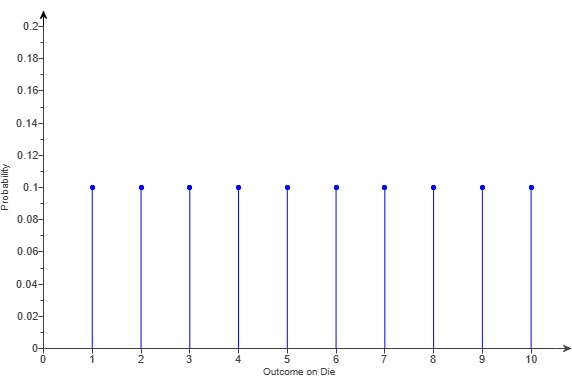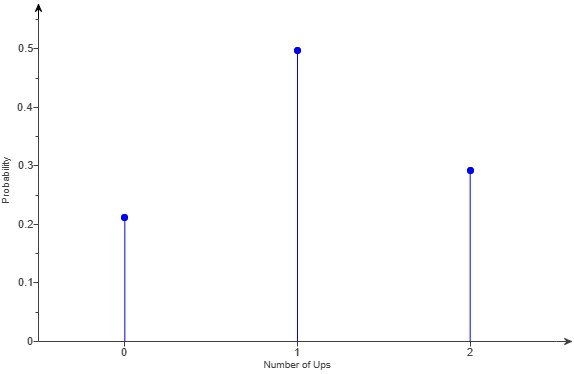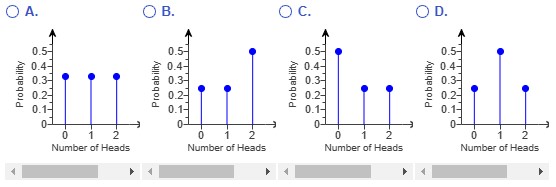(7.) A gambler shaved an edge off one side of a six-sided die, and as a result, the die is no longer
"fair."
The figure shows a graph of the probability distribution function (pdf).
Show the pdf in table format by listing all six possible outcomes and their probabilities.

$ P(1) = P(6) = 0.03 \\[3ex] P(2) = P(3) P(4) = P(5) = k \\[3ex] \Sigma Probability = 1 \\[3ex] P(1) + P(2) + P(3) + P(4) + P(5) + P(6) = 1 \\[3ex] 0.03 + k + k + k + k + 0.03 = 1 \\[3ex] 4k + 0.06 = 1 \\[3ex] 4k = 1 - 0.06 \\[3ex] 4k = 0.94 \\[3ex] k = \dfrac{0.94}{4} \\[5ex] k = 0.235 \\[3ex] $
The figure shows a graph of the probability distribution function (pdf).
Show the pdf in table format by listing all six possible outcomes and their probabilities.

$ P(1) = P(6) = 0.03 \\[3ex] P(2) = P(3) P(4) = P(5) = k \\[3ex] \Sigma Probability = 1 \\[3ex] P(1) + P(2) + P(3) + P(4) + P(5) + P(6) = 1 \\[3ex] 0.03 + k + k + k + k + 0.03 = 1 \\[3ex] 4k + 0.06 = 1 \\[3ex] 4k = 1 - 0.06 \\[3ex] 4k = 0.94 \\[3ex] k = \dfrac{0.94}{4} \\[5ex] k = 0.235 \\[3ex] $
| Number of spots | 1 | 2 | 3 | 4 | 5 | 6 |
| Probability | 0.03 | 0.235 | 0.235 | 0.235 | 0.235 | 0.03 |
(8.) Cardano plays lottery games.
If he picks a sequence of three digits from the numbers 0 through 9 in a lottery game, he will pay $1.35 because he has to pay $1.35 to play the game.
If he picks the same sequence of three digits in a drawing, he will win $487.75
(a.) How many different selections are possible?
(b.) Determine the probability of winning the lottery game
(c.) Calculate Cardano's net profit if he wins the lottery game
(d.) Calculate the expected value
(a.) The question did not specify whether the numbers can be picked: with or without repetition
The default is to assume that ghe numbers can be picked with repetition.
0 through 9 consists of 10 digits
$\underline{0 - 9}$ $\underline{0 - 9}$ $\underline{0 - 9}$
$\underline{10}$ $\underline{10}$ $\underline{10}$
Number of different selections
= $10 * 10 * 10
= 1000$ selections
$ (b.) \\[3ex] n(Winning) = 1 * 1 * 1 = 1 \\[3ex] n(S) = 10 * 10 * 10 = 1000 \\[3ex] P(Winning) = \dfrac{n(Winning)}{n(S)} \\[5ex] = \dfrac{1}{1000} \\[5ex] (c.) \\[3ex] Net\;\;profit = Winning\;\;amount - Amount\;\;to\;\;play \\[3ex] = 487.75 - 1.35 \\[3ex] = \$486.40 \\[3ex] $ (d.)
$ P(Winning) = \dfrac{1}{1000} \\[5ex] P(Losing) = 1 - P(Winning) ...Complementary\;\;Rule \\[3ex] P(Losing) \\[3ex] = 1 - \dfrac{1}{1000} \\[5ex] = \dfrac{1000}{1000} - \dfrac{1}{1000} \\[5ex] = \dfrac{1000 - 1}{1000} \\[5ex] = \dfrac{999}{1000} \\[5ex] $
$ E = \Sigma[x * P(x)] \\[3ex] E = -\$0.86225 \\[3ex] E \approx -\$0.86 $
If he picks a sequence of three digits from the numbers 0 through 9 in a lottery game, he will pay $1.35 because he has to pay $1.35 to play the game.
If he picks the same sequence of three digits in a drawing, he will win $487.75
(a.) How many different selections are possible?
(b.) Determine the probability of winning the lottery game
(c.) Calculate Cardano's net profit if he wins the lottery game
(d.) Calculate the expected value
(a.) The question did not specify whether the numbers can be picked: with or without repetition
The default is to assume that ghe numbers can be picked with repetition.
0 through 9 consists of 10 digits
$\underline{0 - 9}$ $\underline{0 - 9}$ $\underline{0 - 9}$
$\underline{10}$ $\underline{10}$ $\underline{10}$
Number of different selections
= $10 * 10 * 10
= 1000$ selections
$ (b.) \\[3ex] n(Winning) = 1 * 1 * 1 = 1 \\[3ex] n(S) = 10 * 10 * 10 = 1000 \\[3ex] P(Winning) = \dfrac{n(Winning)}{n(S)} \\[5ex] = \dfrac{1}{1000} \\[5ex] (c.) \\[3ex] Net\;\;profit = Winning\;\;amount - Amount\;\;to\;\;play \\[3ex] = 487.75 - 1.35 \\[3ex] = \$486.40 \\[3ex] $ (d.)
$ P(Winning) = \dfrac{1}{1000} \\[5ex] P(Losing) = 1 - P(Winning) ...Complementary\;\;Rule \\[3ex] P(Losing) \\[3ex] = 1 - \dfrac{1}{1000} \\[5ex] = \dfrac{1000}{1000} - \dfrac{1}{1000} \\[5ex] = \dfrac{1000 - 1}{1000} \\[5ex] = \dfrac{999}{1000} \\[5ex] $
| Event | $x$ | $P(x)$ | $x * P(x)$ |
|---|---|---|---|
| Lose the game | $-1.35$ | $\dfrac{999}{1000}$ | $-1.34865$ |
| Win the game | $486.40$ | $\dfrac{1}{1000}$ | $0.4864$ |
| $\Sigma[x * P(x)] = -0.86225$ | |||
$ E = \Sigma[x * P(x)] \\[3ex] E = -\$0.86225 \\[3ex] E \approx -\$0.86 $





